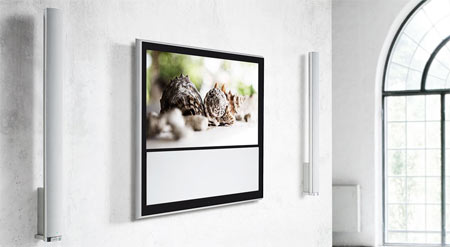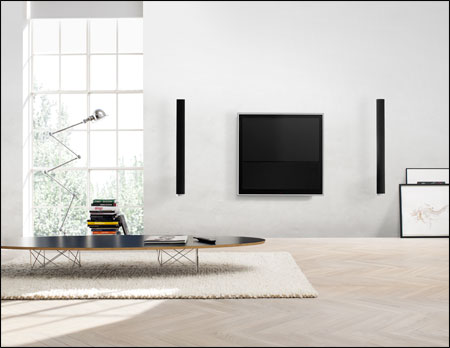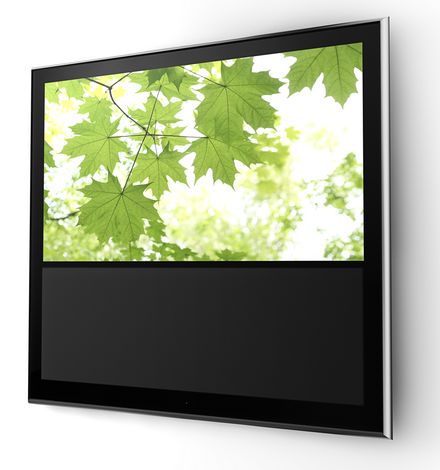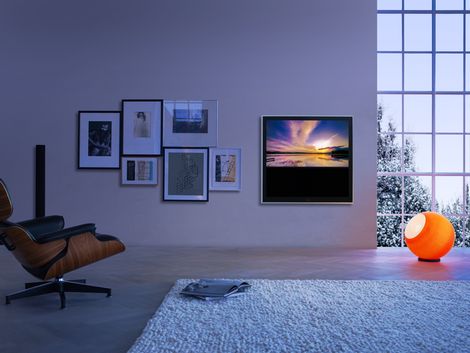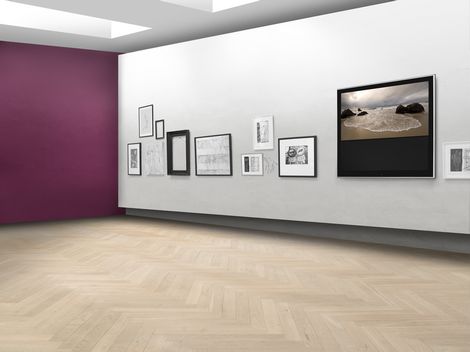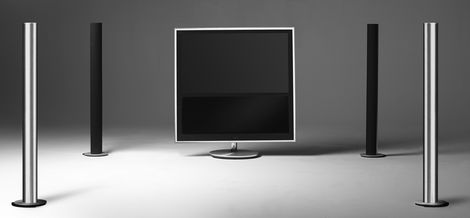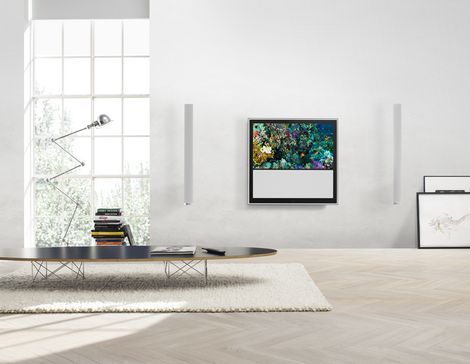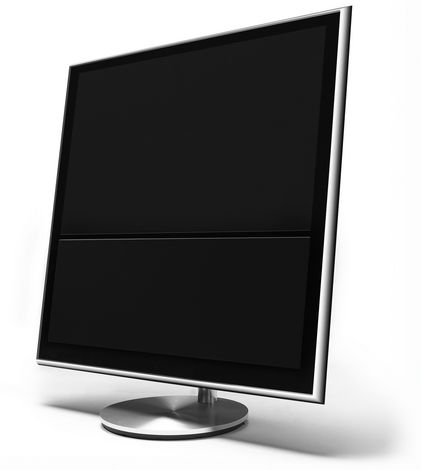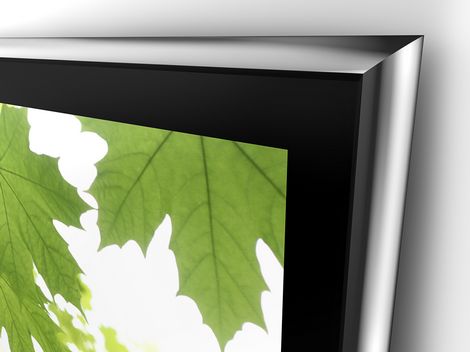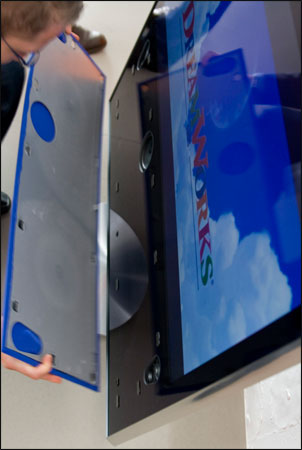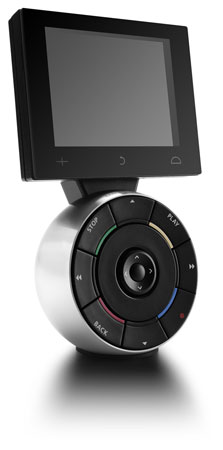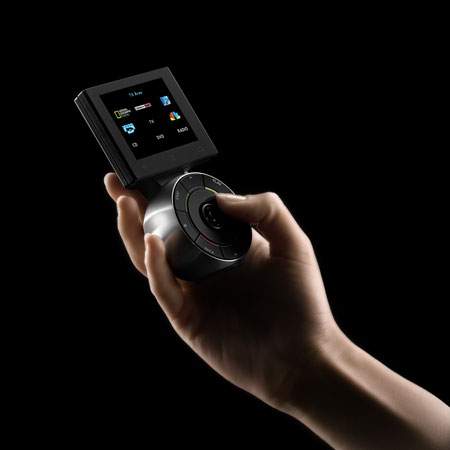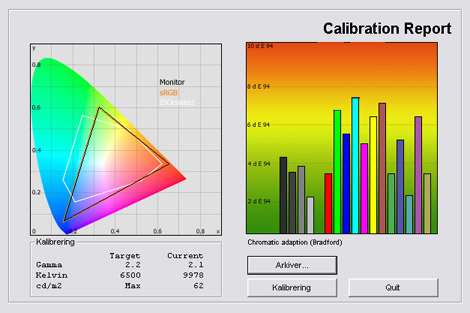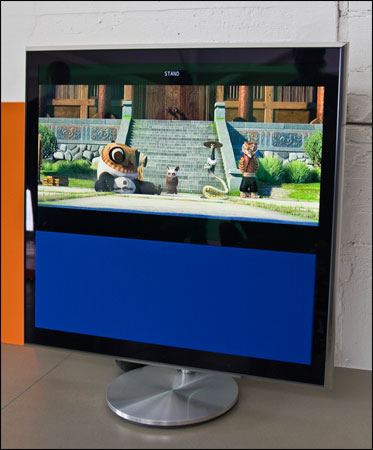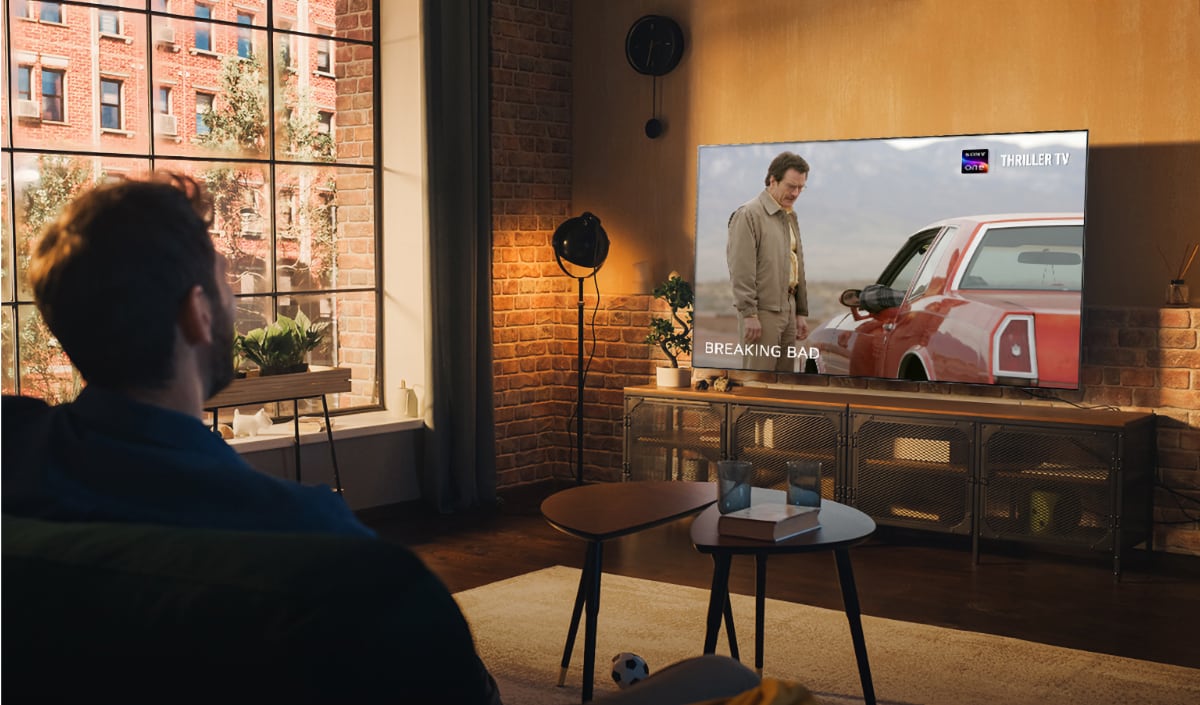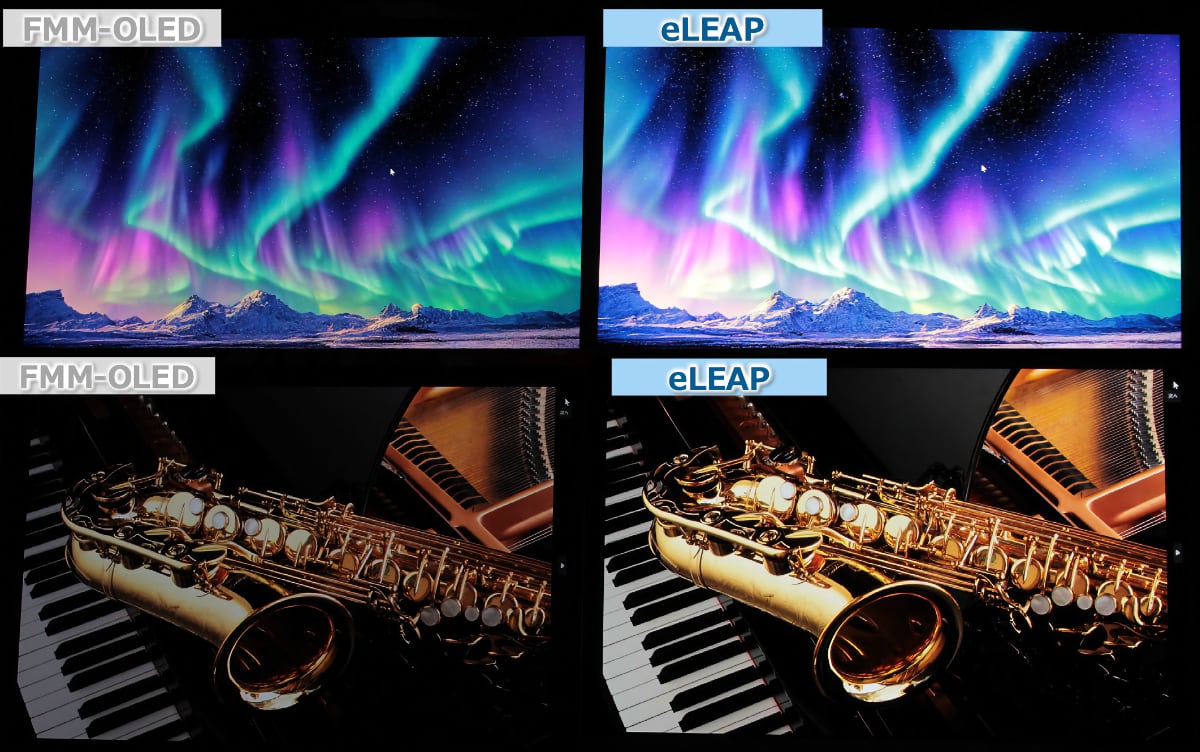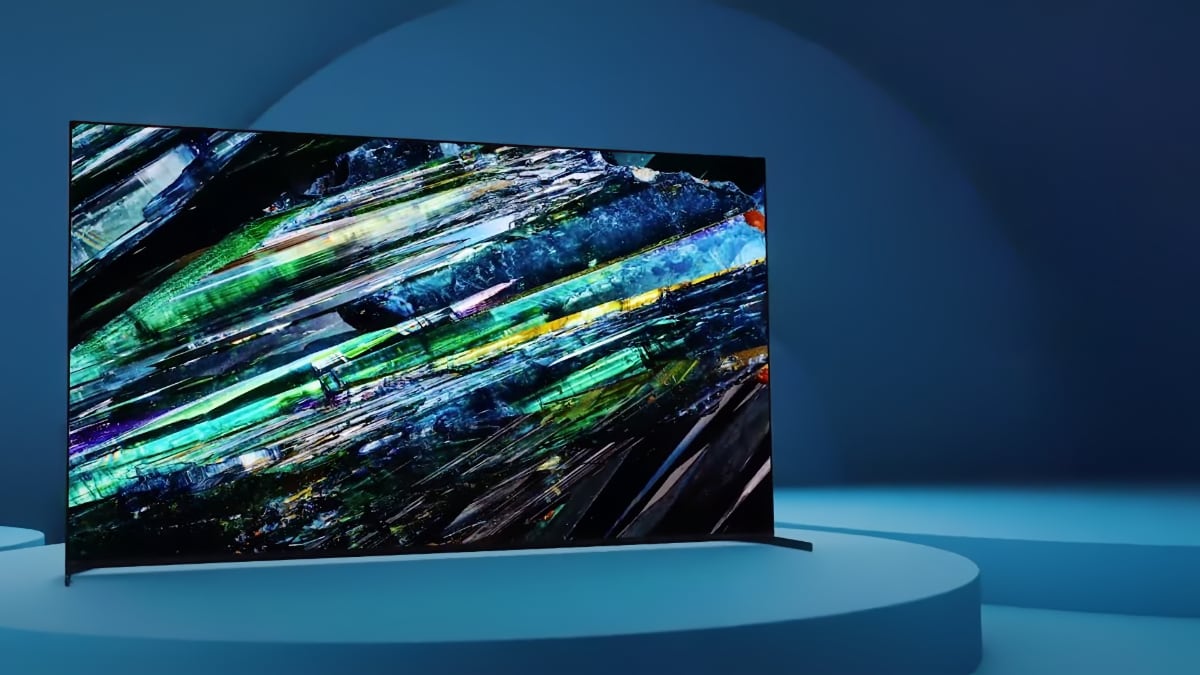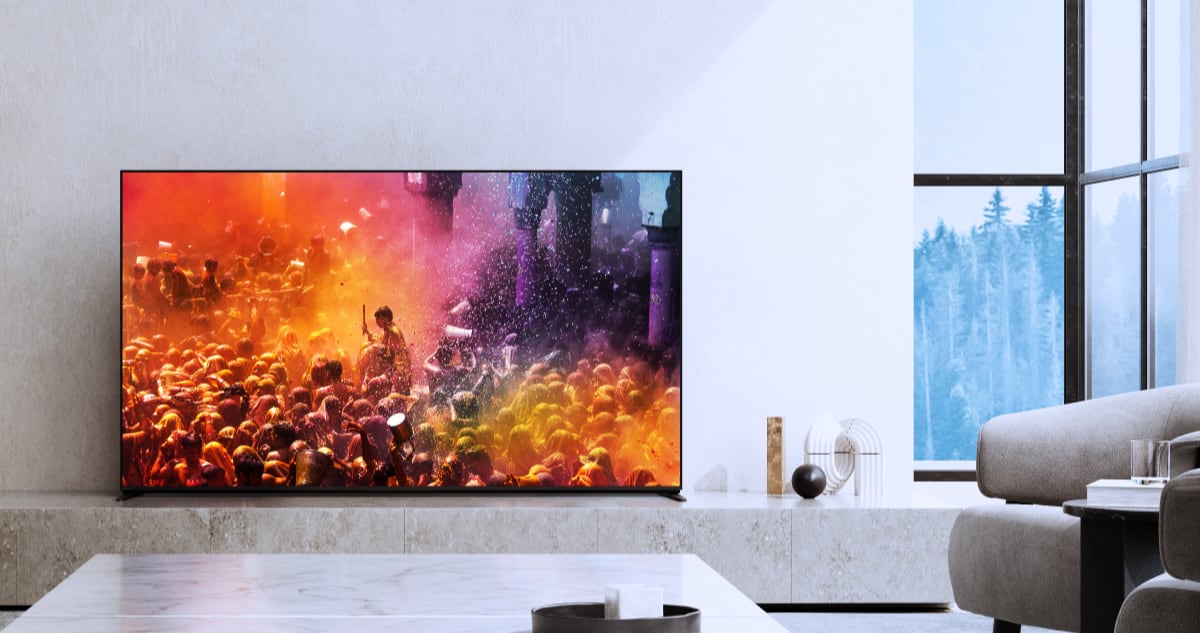B&O BeoVision 10
FlatpanelsHD has looked forward to this BeoVision 10 test. The BeoVision 10 launch was followed intently by both consumers and the media, and was heralded by Bang & Olufsen’s proclamation that the world was about to witness a unique new flat screen system. The BeoVision 10 is unique in many ways, but most importantly, it demonstrates a combat readiness which Bang & Olufsen and its flat screen segment has been lacking for a number of years.
The BeoVision 10 has undergone more rapid development than any other Bang & Olufsen flat screen, because they have built on the foundation from earlier flat screens, rather than reinventing the wheel. The first Bang & Olufsen flat screen system designed to hang on the wall has now entered the market. The BeoVision 10 has also been endowed with a 200 Hz refresh rate, digital tuners, and LED backlighting, silencing any criticism of Bang & Olufsen’s technological weakness.
The BeoVision 10 appears to mark a turning point for Bang & Olufsen flat screens, and a new step for the tradition-laden Danish manufacturer, yet it is still quintessentially Bang & Olufsen – with good sound and picture quality, and a flamboyant and modern design. But will the BeoVision 10 stand up to scrutiny? FlatpanelsHD will find out in this test, where we take a look at the BeoVision 10 and its picture quality.
The BeoVision 10 screen is 40 inches in size. We tested the BeoVision 10 with an anti-reflection coating, on a motorised pedestal, with a Beo5 remote-control.
The BeoVision 10 costs Ł6,000(incl. Beo4). Price varies from country to country. BeoVision 10 also exists with a anti-reflective coating.
Panel size: 40" widescreen (LCD) Resolution: 1920x1080 Response time: - Contrast ratio: - Brightness: - Colour support: 16,7 millions Signal processing: 8 bit for each colour Viewing angles (H/V): 178/178 Dot pitch: - Panel type: LCD (Samsung) Wall mounting: Swivel stand: Dimensions(HxWxD): 101 cm x 96 cm x 7 cm (without stand) Weight 26 kg Built-in speakers: Input formats: 480p/i, 576p/i, 720p, 1080i & 1080p (50, 60 & 24p) 1:1 pixel mapping: Inputs • VGA • DVI (can be converted through HDMI)
• Audio (type) (Audio in/out)
• SCART (2 inputs)
• S-video • Composite • Component 
• HDMI (2 inputs)
• Andet Outputs • Audio (type) (1 output)
• SCART • S/PDIF (optical)
Tuners • Analogue • DVB-T • DVB-T (MPEG4) • DVB-C • DVB-C (MPEG4) • DVB-S • DVB-S (MPEG4)
First impressions of the BeoVision 10
Bang & Olufsen have always been recognized for design. Over the years, Bang & Olufsen have always taken the lead and shown how to create timeless electronic products.
Bang & Olufsen’s products have always been loved and hated, but demonstrate that Bang & Olufsen has taken a different approach to the market than many other manufacturers of electronic products. Most producers have only recently come to realise that televisions, speakers, and other electronic products are part of the home, and therefore also pieces of furniture, whereas this has been a fundamental aspect of Bang & Olufsen’s dedicated work since it was founded, and a major factor in its success.
A piece of furniture – such as the BeoVision 10 – does not have to be bashful and discreet. It is allowed to stand out and light up the room. It should pique the senses, so that a TV is not just a TV, but a piece of furniture – a holistic experience. The BeoVision 10 has a discreet yet provocative design, emphasised by the option to decorate the device with an orange speaker front. The end result is a product which fulfils its duties in terms of sound, picture, and interior design.
The BeoVision 10 also goes against the widescreen format trend. Whereas Phillips has recently launched an extra wide Cinema 21:9 TV, which is wider in the horizontal dimension, Bang & Olufsen have turned things 90°, claiming that the vertical format is softer on the eye, as these are the proportions which dominate picture frames and other furniture elements in the home.
There is a built-in speaker under the screen, and despite the thinness of the BeoVision 10, Bang & Olufsen have promised surprisingly full sound from the device. We will naturally take a closer look at this later in a review.
The BeoVision 10 is created to hang on the wall, using a wall bracket which can be mounted on either the left or right-hand side, as preferred. This means that once the television has been mounted, you can only swivel it out from the wall in one direction. The wall bracket is not motorised, which means you have to drag yourself out of the sofa and do it manually.
We tested the BeoVision 10 on a motorised pedestal. This may seem paradoxical given that the television has been created to hang on the wall, but we are unable to wall-mount all the televisions we test, for practical reasons. The motorised pedestal can be rotated using the remote control, and moves in a very fluent and elegant manner. For example, you can set up different profiles for video, sound and standby, so the television automatically moves into the desired position for the given situation.
The television is made of high-gloss polished aluminium with a jet black screen which is indistinguishable from the jet black background and frame when the television is switched off. The frame is divided into a front and rear profile, making the television appear even thinner. The rear profile is virtually invisible, even when you look at the television from the side, and reflects the colour of the wall, so that the television looks like a striking extension of the wall.
The materials the BeoVision 10 is made from are in a completely different class to those of the BeoVision 8-40, which we most recently reviewed. The latter is an entry-level model, while the BeoVision 10 is the epitome of Bang & Olufsen quality – stylish, elegant, and sturdy.
The speaker at the bottom of the BeoVision 10 is covered by a fabric frame which can be easily removed. These covers are currently available in black, white, silver, dark grey, blue, and orange, but Bang & Olufsen expects further colours to eventually become available.
We used a standard black cover during testing, but had the opportunity to see the BeoVision 10 with both a blue and an orange front cover. These certainly create a different design expression, but can be distracting when you simply want to watch a movie on the television.
The designer behind the BeoVision 10 is, not surprisingly, David Lewis, who is becoming a familiar name in Bang & Olufsen circles.
All connectors are positioned facing downward at the rear of the TV. These include the screen’s two HDMI inputs and digital tuners, and link options for connecting other Bang & Olufsen devices.Test tools
Our TV signal is DVB-S (satellite) from Canal Digital and DVB-T (terrestrial). We also have an analogue TV connection.
Testing is done with the DVE (digital video essentials) and Peter Finzel test DVD. Testing is also done with DVD, TV, Blu-Ray and Mediacenter/PC.
We also use our own monitorTest . The software supports some of the traditional test patterns used to evaluate displays as well as some new and unique test patterns developed by the people here on Flatpanels.
Sony PlayStation 3 is our Blu-Ray player.Bang & Olufsen Functionality
We used the Beo5 remote control during testing, which supersedes the well-known Beo4 remote control (still on the market). The Beo5 remote control has a quite unusual design expression, which yet again divides opinion due to its provocative shape.
The Beo5 remote control has a touch panel at the top which controls a number of functions on Bang & Olufsen products, as well as physical buttons underneath, including a wheel to control volume.
The Beo5 is a little difficult to master and it takes some time before one understands the logic, but the Beo5 then becomes quite a useful tool. It can naturally be programmed to control all Bang & Olufsen devices, but can also be extended to control other Bang & Olufsen compatible devices.
The touch screen provides very flexible options for adding functions for other units. The Beo5 also has various zones, so you can select a dedicated zone to manage light, for example.
It is extremely clever, but you need to take time to familiarise yourself with it, or take a crash course from Bang & Olufsen in navigating within the Bang & Olufsen world.
I will not examine the link options for other Bang & Olufsen products, primarily because we do not currently have any Bang & Olufsen products apart from the BeoVision 10 (and soon the new 55” BeoVision 7-55), and also because this review focuses primarily on the BeoVision 10’s picture and sound quality.
The Bang & Olufsen menus are simple enough, but if you are used to using other TV navigation menus, they can take a little getting used to. The screen menus do not give the user much freedom to change picture settings. You can basically only choose between brightness, contrast and colour.
While Bang & Olufsen has some more advanced menus, these are not directly accessible, as Bang & Olufsen's video circuitry takes care of most of the tasks users normally want to influence. We will return to the BeoVision 10 picture systems in the section on picture quality.Power consumption
The power consumption figures for BeoVision 10 are as follows:
| Out-of-Box | After calibration | |
| Stand-by | 0,8 W | 0,8 W |
| SD | 139 W | 107 W |
| HD | 139 W | 107 W |
These power consumption figures are for the BeoVision 10-40 (40”). Please note that power consumption varies significantly because the BeoVision 10 has a built-in light sensor which adjusts the screen light intensity in response to ambient light levels. The BeoVision 10 light levels are therefore more subdued during the evening than during daylight hours.
The highest figure in the table above was the average for a typical day with mixed sunshine and cloud (Denmark at its best), while the second figure was for a typical evening, after making a few adjustments to the screen menu.
Comparison of the figures for the BeoVision 10 and BeoVision 8-40 reveals that BeoVision 10 power consumption has been significantly reduced. This is because the BeoVision 10-40 uses LED backlighting. LED technology helps to significantly reduce power consumption.
BeoVision 10 picture quality
I would like to begin by briefly introducing the elements which make up the BeoVision 10, as it has a number of built-in modern and technological features. The BeoVision 10 proves that Bang & Olufsen is no longer lagging technologically, as some claimed, when criticism of their failure to launch contemporary products was at its highest.Bang & Olufsen’s new focus and new CEO, Kalle Hvidt Nielsen, have resolved these issues in my opinion. I am not qualified to comment on Bang & Olufsen's sound segment or the other segments outside the flat screen segment, but with respect to flat screens, the BeoVision 8-40, marked the first important step. People were looking for a larger television for their lounge room, and when the BeoVision 8 came out as a 26” and then a 32” model, the market had already long moved on, and 40-42” is the most common in homes today.
Bang & Olufsen was simply too slow with the BeoVision 8 - twice – but the BeoVision 8-40 was the first step in the right direction. The BeoVision 10 has now taken the next step, and a 40” model is a good starting point, not only because it targets a high-demand segment, but also because it is technologically well-positioned in relation to the other televisions in a market which is moving much faster today than a few years ago, as Bang & Olufsen has also had to recognize.
The level of technological advancement was something Bang & Olufsen received a lot of criticism for previously with respect to their flat screens. I see the final step as having been taken with the 55” BeoVision 7-55. This model is naturally positioned in a completely different price range, but it shows how Bang & Olufsen is now a technological leader, with a genuine high-end model which is a true technological wonder.
Returning to the BeoVision 10. I personally believe that picture quality is a combination of many factors which all have to be optimised and perfect. It is essential to have good colour reproduction, a deep black, good handling of movement, good video circuitry, etc, and when all these things work flawlessly together, the picture quality is lifted to a new level. Picture quality is therefore not just a hotchpotch of randomly chosen picture technologies, with their own individual purposes. The elements have to play together as a team, rather than as 11 individual superstars each meandering in their own direction, to use a football metaphor.
In terms of technology, the BeoVision 10 has an LCD panel using LEDs, as has been seen in Samsung’s new ’LED-TV’. The BeoVision 10 also has a 200 Hz system, ranking them among the elite, but how do these elements work together in practice, and has Bang & Olufsen managed to get more out of their flat screen than the others?
I will start by performing some measurements on the BeoVision 10 below, and then talk about the television based on these. I will then examine the practical elements of the picture quality – how I perceived the picture quality on the BeoVision 10, and how the picture is reproduced in practice, compared against my measurements.
I measured the BeoVision 10 picture quality initially, without changing any settings. The results are shown below:
The graph says this:
The number on the left is the delta value. Delta is a difference between two factors; here it’s the difference between the measured colour on the panel and the actual colour that is our target.
The graph above illustrates how the BeoVision 10 reproduces colour, colour temperature and gamma values. Colour deviations from the correct values are shown on the right side of the graph. The BeoVision 10 colours are not 100% precise, but this is due to two factors. Firstly, we measured a colour temperature of approximately 8500 Kelvin. The graph above shows a value of 9988 Kelvin, but that is the highest value measured, whereas 8500 Kelvin is the average.
Our measurements also show that the gamma value is a little too high, fluctuating from 2.15 to 2.4. Our target gamma value is 2.2. Deviations in the gamma value mean that colours are reproduced too dark or too light. The slightly higher gamma value we measured for the BeoVision 10 means that light colours are displayed a tad too dark, and that dark colours are displayed a tad too dark. The midrange colours, and medium-intensity red and blue, for example, are reproduced satisfactorily.
The effect of a slightly high colour temperature is that the BeoVision 10 picture is slightly more blue or “cold” than our target colour temperature. Our target colour temperature is 6500 Kelvin, as this results in a slightly redder, “warmer” picture.
When we reviewed the BeoVision 8-40 we asked Bang & Olufsen why they aimed for this colour temperature, and we were told that this was a conscious choice, based on blind tests involving a number of users. People generally preferred the slightly bluish picture, and Bang & Olufsen therefore cater to this preference on their flat screens.
At this point I adjusted the settings on the BeoVision 10. You can do this by changing the values of the various settings in the TV menus to achieve an even better picture. Bang & Olufsen have done the legwork, so fewer parameters can be changed than is the case for many other flat screens, but the standard settings for other flat screens are also significantly worse than for Bang & Olufsen's flat screens.
Picture measurement following calibration/adjustment is shown below:
I was able to slightly improve the picture. The gamma value is still shown as 2.1 in the graph above, but this is an average. If I take this value for the measurements of all the colours, from the very light to the very dark, the gamma value for Bang & Olufsen now ranges from around 2.15 to 2.35, which is a great base range, and also creates slightly better balance between the lighter and darker colours.
However, I was unable to change the colour temperature, which still lies around 8500-9000 Kelvin. This means that the picture on the BeoVision 10 is slightly more bluish than our target colour temperature, but not critically so. I would still like to see the option of selecting a 6500 Kelvin colour temperature from the Bang & Olufsen menu – for example as a movie mode which can be manually selected.
The table below shows the measurements I worked out during calibration:
| After calibration | |
| Light: | -1 |
| Contrast | -4 to -5 |
| Colour: | 0 |
| Size: | Middle |
Note in the above table that 0 means that I let the settings remain in the middle (Bang & Olufsen don't use numbers in their menus). The contrast value of -4 means that I moved the level four stops to the left. I reduced these settings in order to improve the gamma value. Please note that when using HD sources, such as a Blu-ray player or PlayStation 3, “Size” should be set to “middle” to avoid scaling (resulting in loss of picture definition).
The picture quality on the BeoVision 10 is exceptionally good in practice. The BeoVision 10 exhibits many of the same characteristics we found when testing the BeoVision 8-40.
This means the picture quality has an incredible wealth of detail. It is one thing to be able to reproduce the colours correctly, but another thing to reproduce colour nuances and details. The BeoVision 10 manages to do this even better than the BeoVision 8-40.
The picture comes across as very deep and dynamic, led by a very deep visual reproduction of black. Such a deep black gives the picture much greater depth than if black is reproduced as grey. I will test black using measuring instruments later in the review.
We tested the BeoVision 10 with an anti-reflection coating, which aims to reduce reflection on the screen. The coating works to some extent, but the shiny surface is not completely free of reflection. With the sun low in the sky here in autumn, these reflections can detract slightly from viewing pleasure. The coating reduces some of the effect by breaking the light into blue and yellow, but does not completely eliminate reflection.
Bang & Olufsen’s video circuitry is called VisionClear. I won’t say much about the technical aspects of VisionClear here.
The VisionClear system is capable of reproducing a beautiful picture. The level of detail is very high, and the television provides impressive picture reproduction for both movement and still pictures. The 200 Hz system contributes to this effect. The advance over previous Bang & Olufsen systems is that the new televisions reproduce more images (200/second versus 100 previously) and the 100 Hz is adapted in relation to the picture material on the screen.
100 Hz on an LCD screen is completely different to on a picture tube television. Bang & Olufsen’s 200 Hz is more than what meets the eye. It is a proprietary system which adjusts the level of smoothing and blur-reduction to match the content displayed on the screen. The patented Bang & Olufsen 100/200 Hz variant is therefore more advanced than what other producers boast, because it appraises the situation and adjusts the system accordingly.
100/200 Hz systems have to perform two tasks. Bang & Olufsen studies have found that film judder is very dependent on how bright screen images are. High-contrast pictures seem to flicker without 100/200 Hz, while those with low contrast appear more blurred without 100/200 Hz. The system therefore has to deal with two issues, flicker and blur.
Bang & Olufsen’s 200 Hz system makes adjustments for these on the BeoVision 10 when it is set to ”Auto” in the menu. It produces good results, and just as I praised the 100 Hz system on the BeoVision 8, the 200 Hz system on the BeoVision 10 also deserves praise. The improvement over Bang & Olufsen’s 100 Hz system is not huge, but it does give the feeling of a slightly more fluid picture.
The technology also helps maintain a high degree of detail during movements, so they do not become blurred, and the BeoVision 10 actually has one of the best response times I have seen for a flat screen television. The scanning backlight technology used in LG’s SL8000 and Philips 9704H is one or two steps ahead, but the BeoVision 10 does the job at almost the same level.
Note that the 200 Hz system contributes to a slight input lag when using game consoles such as PS3 and Xbox360. This can be resolved by disabling the 200 Hz feature in the menu when you connect a game console.
200 Hz systems also add slight noise around moving objects for very poor and compresses signals, but the picture noise has generally been reduced to a minimum.
Standard TV signals – both analogue and digital, are also excellently reproduced. The analogue signals have slight noise, but the BeoVision 10 produces one of the most pleasant analogue pictures I have seen on an LCD TV. Even very compressed and uninspiring broadcasts get a breath of life from the BeoVision 10, and I have to admit that Bang & Olufsen’s video circuitry is quite unique.
I found that the video circuitry adds slight artificial sharpness to the signal. This can be too pronounced for HDTV signals, but is not very noticeable to the untrained eye. I would still appreciate the option of being able to reduce this artificial sharpness slightly in the screen menu.
HDTV is sheer viewing pleasure on the BeoVision 10. Both HDTV and Blu-Ray are reproduced in a way that few TVs can match. The level of detail is incredibly high because dark, midrange and light colour details are reproduced so precisely.
The BeoVision 10 also displayed 1080p24 material from a Blu-Ray player.
I also measured black reproduction:
| Out-of-Box | After calibration | |
| Black level | 0,06 cd/m2 | 0,03 cd/m2 |
| Brightness | 92 cd/m2 | 62 cd/m2 |
| Contrast ratio | 1533:1 | 2067:1 |
Contrast ratio +/- 50
The BeoVision 10 adjusts the screen light intensity based on ambient light levels. As a result, the black level varies slightly during daylight hours compared to the evening, but the dynamic human iris minimises the effect of this, as one is not nearly as sensitive to small variations in very dark colours during the day (as these require great light sensitivity from the eye). The most important issue, therefore, is how black is reproduced under darker conditions, such as on a grey autumn day or during the evening (also prime viewing times).
As my figures in the table above show, I measured a very low black level for the BeoVision 10. This was significantly better than for the BeoVision 8-40, and actually the deepest black I have ever measured on an LCD-TV, excepting only the Philips 9704 with LED Pro. This provides a fantastic perception of depth in the BeoVision 10 picture, and incredibly good picture reproduction during the evening.
Shadow detail –the ability to distinguish the darkest shades from each other – is also excellent. It is not 100% perfect, but is at a level which puts Bang & Olufsen far ahead of most televisions today. I was able to distinguish virtually all the various dark grey nuances, and this is impressive given the deep black level.
There is usually a compromise between shadow detail and black level, as we witnessed for the Philips 9704. You either have a very deep black and poor separation between dark shades (shadow detail), or good shadow detail and a grey reproduction of black. The BeoVision 10 combines the best of both worlds, reproducing a very deep black while maintaining good detail for the darkest shades.
I also investigated whether there was evidence of ‘clouding’ on the television. Clouding refers to the phenomenon on LCD panels whereby the light is unevenly distributed over the screen surface. This can often be seen during dark scenes or in the black bars at the top and bottom of wide-screen movies. LED-TV’s have not eliminated this problem, because the LEDs are often placed along the edge of the panel, which makes it relevant to check for this on the BeoVision 10, since it uses LEDs.
I found a very, very weak susceptibility to clouding on the BeoVision 10. It was so weak, however, that it was not noticeable in practice, which may also be due to the low black level on the BeoVision 10 (the best I have yet measured on an LCD-TV). A very low black level places even greater demands on a panel’s light homogeneity.
I was also able to detect a hint of light inhomogeneity on the Pioneer KURO plasma TV, if I looked very carefully, but I have never heard users complain about this subsequently, and the same will be the case for the BeoVision 10.
PC and media center
I had no problems connecting the BeoVision 10 to a PC. In order to achieve correct 1:1 pixel mapping (i.e. correct picture scaling and the best definition) ”Size” must be set to ”middle” in the screen menu. This also applies to Blu-ray players and game consoles such as PlayStation 3, where “Size” needs to be set in the same way.Viewing angles
Viewing angles are among the best for an LCD TV, though not yet perfect. There is no problem with viewing the BeoVision 10 from an angle, but I would recommend that you swivel the TV rather than view it from a very wide angle.Black loses some of its intensity viewed from an angle, and the colours are slightly different.
BeoVision 10 sound
The BeoVision 10 yet again illustrates Bang & Olufsen’s dedication in the area of sound. The BeoVision 10 is the thinnest Bang & Olufsen television available, but this does not mean they have been willing to compromise on good sound, as good sound is always a part of Bang & Olufsen's products. It is, of course, possible to connect external speakers – such as BeoLab 5 – to the BeoVision 10, but the integrated speaker in the BeoVision 10 has been an important part of Bang & Olufsen's product development.What’s our verdict? We recently praised the BeoVision 8-40 for its good sound, but its “orchestra pit” at the base provides more space for the vibration essential to good sound reproduction. The speaker system is designed around an active two-way stereo speaker system, with centre base, and a newly developed bass port.
The BeoVision 10 performs superbly. It creates good sound, with good depth in the bass tones and excellent reproduction in the midrange tones. I miss having slightly more bass in the overall sound, but the television still manages to use the cabinet to produce a full sound, as we also found with the BeoVision 8-40.
The BeoVision 10 is a thin television, and this naturally limits the sound options. As flat screens become thinner and thinner, the sound is also becoming more flat, as we have also found with the very thin LED-TVs on the market.
However, the BeoVision 10 manages to go in the opposite direction. A thin television does not mean the sound has to be thin, and the BeoVision 10 therefore fulfils Bang & Olufsen's promise of really good sound from a small cabinet – but it does not set any new standard for BeoVision TV sound quality as I see it. However, as I also said when I reviewed the BeoVision 8-40, Bang & Olufsen’s sound quality simply cannot be compared to the sound quality of some of the other flat screen televisions. Bang & Olufsen is simply in a different class – and this is also very much true for the BeoVision 10.
Conclusion
The BeoVision 10 has already attracted an incredible amount of attention. FlatpanelsHD was able to provide this first test of the BeoVision 10 because we had a unique opportunity to get hold of the product, which is already on back order several weeks into the new year.With a price tag of around Ł6000 (incl. remote control), expectations are already running high. As is often the case, high expectations can be dangerous – if the product fails to meet them, the disappointment is all the more great. But the BeoVision 10 has not disappointed us – the BeoVision 10 has kept its promises.
The BeoVision 10 presents resplendent picture quality, with one of the deepest blacks I have ever measured for a television, excellent colour reproduction and incredible handling of rapid sport and action movements due to its 200 Hz system. The picture is a touch too blue compared to our reference target, and there is a tad too much artificial sharpness in the picture occasionally, but these things have little impact on the overall experience of fantastic picture quality, wrapped up in the BeoVision 10’s unique design.
The BeoVision 10 has many characteristics in common with the BeoVision 8 series, but Bang & Olufsen have still managed to take picture quality a step further in most areas. The sublime sound quality also inspires admiration. It is, of course, unable to match Bang & Olufsen’s separate sound systems, but despite its slim cabinet, the BeoVision 10 delivers an incredibly full sound through its innovative speaker system, with good bass and midrange reproduction.
If we put it all together – beautiful picture quality and a sublime sound system with a built-in surround amplifier, excellent construction and quality materials, while also noting that the television is created as a piece of furniture for the home – what we have is a fantastic product from Bang & Olufsen. Although the BeoVision 10 may be the fastest television to have come through Bang & Olufsen’s development department, this is in no way reflected in the product. One senses Bang & Olufsen’s dedication to their work and fastidious approach, leading to the creation of a top-class television.
The Bang & Olufsen BeoVision 10-40 has therefore been given a Top Recommendation Award based on the overall product, and evaluation of its picture, sound, amplifier, design/materials, furniture effect and quality.
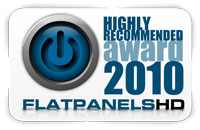
Press the award logo to learn more.
You can start looking forward to our BeoVision 7-55 test, or re-read our review of the Bang & Olufsen BeoVision 8-40. Subscribe to our newsletter and you will be notified whenever new reviews become available online.
| Pros | Cons | Target group |
| Impressive picture quality | Only 2 HDMI inputs | Living room |
| Good, full sound | Viewing angles not perfect | Home cinema |
| 200 Hz system | 200 Hz adds slight noise for poor signals | |
| Deep black reproduction | ||
| Good standard settings | ||
| Construction quality | ||
| Link system and operation |

